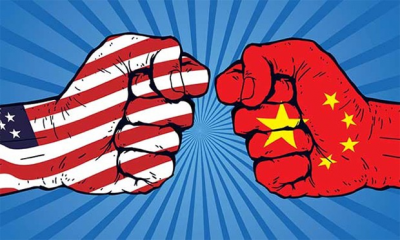Trump War on China by Other Means. Economic Warfare. Things May Get Ugly

China is rising, heading toward becoming the world’s leading economy — already No. 1 ahead of the US on a purchase price basis, what a basket of goods costs in both countries.
Has the Trump regime met its match in China? Its tariffs, sanctions, and other bullying tactics haven’t worked, nor are they likely to ahead.
Trump is ignorant of Beijing’s resolve. Its ruling authorities won’t now or ahead yield their aim to become a leading industrial, economic, and technological world power to US interests.
In May, President Xi Jinping said China is “embarking on a new Long March” — referring to the protracted struggle between Mao Zedong and Zhou Enlai v. US supported Chiang Kai-shek’s nationalist forces, ending with the Red Army’s triumph, the forerunner of the People’s Liberation Army.
At the time, the official Xinhua News Agency said China “has been standing tall in the East for the last 70 years,” adding:
“It has never lowered its head and it has never feared anyone. History will prove again that bullying and threats by the US will not work.”
China is prepared for a longterm struggle in pursuit of its legitimate aims. Unacceptable US actions and bullying haven’t worked and won’t likely succeed ahead.
After 12 negotiating rounds of talks, things are at impasse between both countries because of unacceptable Trump regime demands no responsible leadership would accept.
On August 5, Mike Pompeo falsely accused China of “engag(ing) in trade practices which stole tens and hundreds of billions of dollars of US economic property (sic), that engaged in forced property transfer where American businesses had to give our technology to China just to open up that market (sic),” adding:
The Trump regime seeks “to restructure that set of trading rules for the United States so that they are fair and reciprocal (sic).”
Cold hard reality refutes his disinformation. China seeks cooperative relations with other nations, featuring carrots over sticks — at peace with its neighbors and all other countries.
The US is a global hegemon, using pressure, bullying, and brute force to get other nations to bend to its will, war and other hostile actions its favored tactics — seeking dominion over planet earth, its resources and populations, wanting ruler-serf societies it controls established everywhere.
Talks with China since spring 2018 have little to do with trade, everything to do with the US wanting its development aims undermined — the trade deficit greatly favoring Beijing a minor issue.
It exists because corporate America offshored much of its industrial base and many other jobs to low-wage countries, notably China — US ruling authorities going along by doing nothing to halt the practice.
Since the neoliberal 90s, the US has been incrementally thirdworldized, poverty the nation’s leading growth industry. Most households need two or more jobs to get by.
Most available are rotten part-time/temp, low-pay, few or no benefits ones. The land of opportunity I grew up in long ago no longer exists.
US ruling authorities serve privileged interests exclusively at the expense of the general welfare.
Law enforcement at the federal, state, and local levels is all about serving and protecting monied interests at the expense of ordinary Americans.
On Monday, the Trump regime’s Treasury Department designated China a “Currency Manipulator,” note the caps — a hostile action not about to go down well in Beijing, a Treasury statement saying the following:
“As a result of this determination, Secretary Mnuchin will engage with the (US-controlled) International Monetary Fund to eliminate the unfair competitive advantage created by China’s latest actions (sic).”
“This pattern of actions is also a violation of China’s G20 commitments to refrain from competitive devaluation (sic).”
Here’s what happened. Over the weekend, China let its yuan slip to 7.0982, falling further on Tuesday to 7.0703 to the dollar.
Its January 1994, its all-time high was 8.73 to the dollar — the lower the yuan, the more competitive Chinese exports are in world markets unless offset by currency devaluations elsewhere.
At the same time, Beijing suspended purchases of US soybeans and other agricultural products — its actions in response to Trump’s threat to impose 10% tariffs on another $300 billion worth of Chinese imports and no relief from unacceptable demands during bilateral talks.
Falsely declaring China a currency manipulator is the latest shoe to drop.
The practice involves central banks buying or selling foreign currencies in exchange of their own to influence the exchange rate and commercial policy.
Many nations adjust their currencies to maintain competitiveness, stability, and control inflation.
The People’s Bank of China (PBOC) Governor Yi Gang said the following:
China will “not engage in competitive devaluation, and not use the exchange rate for competitive purposes and not use the exchange rate as a tool to deal with external disturbances such as trade disputes.”
US legislation directs the Treasury Secretary to “analyze on an annual basis the exchange rate policies of foreign countries…and consider whether countries manipulate the exchange rate between their currency and the United States dollar for purposes of preventing effective balance of payments adjustments or gaining unfair competitive advantage in international trade.”
It’s OK for the US to maintain a competitive advantage over other nations by currency manipulation and other practices, not the other way around.
When the dollar’s valuation rises, currencies of other nations decline, China’s in this case so calling the nation a currency manipulator is false. It’s letting the currency fall naturally by not manipulating it higher.
In response to global geopolitical and economic events, including Trump’s trade war with China and US equities at bubble levels, a flight to safety resulted in large-scale buying of US Treasuries.
It sent the 10-year US Treasury’s yield down to 1.75% on August 5 from a multi-year high of 3.14% months earlier. When yields fall, valuations rise.
The yield curve also inverted (the six-month Treasury at 1.99% on August 5), often signaling recession ahead. Rising gold prices to a six-year high also reflect a flight to safety.
Last week, the Fed began what appears to be a rate-cutting cycle, reversing the short-term hiking one, perhaps heading short rates back to zero or below as in Europe, benefitting investors at the expense of savers and individuals on fixed incomes, the vast majority of Americans.
The Trump regime’s geopolitical, economic and financial agenda is responsible for growing chaotic conditions, including in the financial markets.
The tougher Trump gets with China, the more firm its ruling authorities are likely to be in response to defend the nation’s interests.
Trump’s hostile/counterproductive agenda may push world economies into recession, perhaps a stiff protracted one.
Monetary policy won’t save him. It can prop up the stock market with easy money, not turn around economic weakness.
The massive US national debt exceeding GDP, heading higher, precludes fiscal stimulus to stimulate growth
Things may get ugly ahead — perhaps later this year or in early 2020.
*
Note to readers: please click the share buttons below. Forward this article to your email lists. Crosspost on your blog site, internet forums. etc.
Award-winning author Stephen Lendman lives in Chicago. He can be reached at [email protected]. He is a Research Associate of the Centre for Research on Globalization (CRG)
His new book as editor and contributor is titled “Flashpoint in Ukraine: US Drive for Hegemony Risks WW III.”
http://www.claritypress.com/LendmanIII.html
Visit his blog site at sjlendman.blogspot.com.


